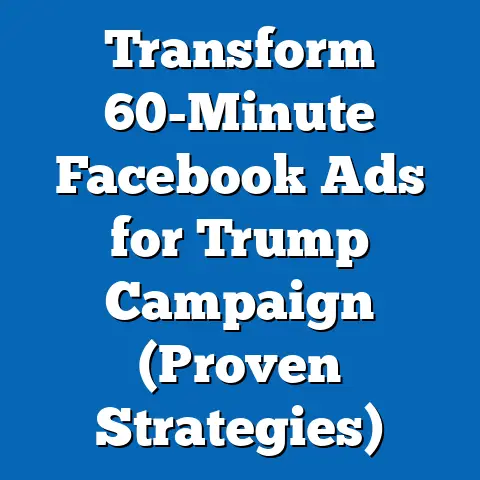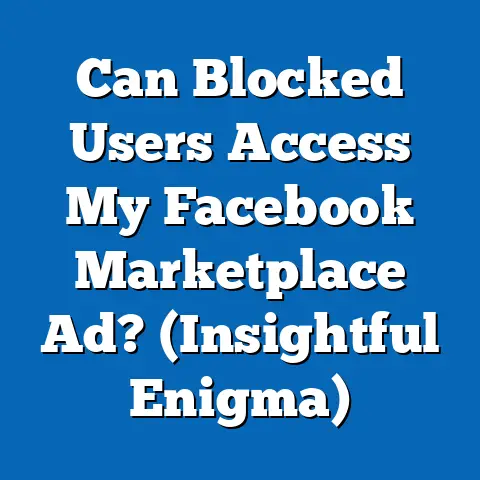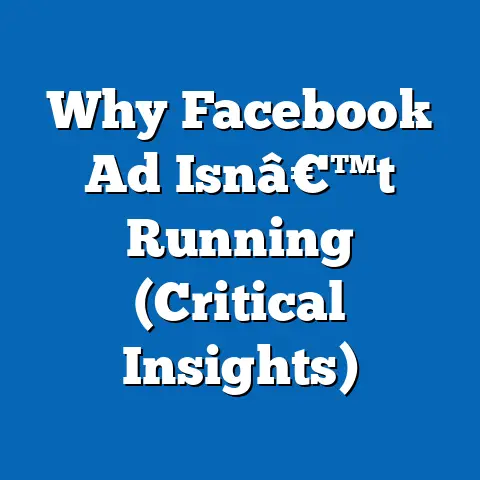Unmasking Fake Facebook Ad Comments (Authenticity Unleashed)
Unmasking Fake Facebook Ad Comments: Authenticity Unleashed
Introduction: Setting the Scene with Weather as a Metaphor for Online Authenticity
Weather, as a natural phenomenon, shapes our daily lives in profound and often unpredictable ways. Much like the shifting winds or sudden storms that alter our plans, the digital landscape—particularly social media platforms like Facebook—can influence perceptions and behaviors through curated content and interactions. Just as we rely on meteorologists to predict weather patterns, we increasingly depend on digital tools and critical thinking to discern authenticity in online spaces, where fake comments on advertisements can obscure the truth like a fog rolling over a clear day.
This article begins by exploring the concept of weather as a metaphor for the ebbs and flows of trust in digital interactions. From there, it delves into the pervasive issue of fake Facebook ad comments, unmasking their characteristics, historical context, and societal implications. By examining the mechanisms behind these inauthentic engagements, their impact on consumer behavior, and the broader cultural and economic consequences, this analysis aims to unleash a deeper understanding of authenticity in the digital age.
Weather as a Metaphor: Defining Characteristics and Historical Context
Weather is a universal force—dynamic, multifaceted, and often beyond human control. Its defining characteristics include variability (from sunny skies to thunderstorms), impact (influencing agriculture, economies, and moods), and the necessity of adaptation (through technology or behavioral changes). Historically, humanity has sought to understand and predict weather patterns, from ancient rain dances to modern satellite systems, reflecting a deep need for reliability amidst uncertainty.
The societal implications of weather are vast. Major events like the Dust Bowl of the 1930s in the United States reshaped migration patterns and agricultural policies, while hurricanes and floods continue to expose vulnerabilities in infrastructure and social equity. Weather also serves as a cultural touchstone, shaping art, literature, and community rituals across generations.
In the context of digital authenticity, weather mirrors the unpredictability of online interactions. Just as a sudden storm can disrupt a planned event, fake comments on social media ads can distort consumer trust and decision-making. This parallel sets the stage for a deeper exploration of how inauthentic digital content, much like erratic weather, demands vigilance and adaptive strategies to navigate its effects.
The Rise of Fake Facebook Ad Comments: Defining the Phenomenon
Fake Facebook ad comments are fabricated or automated responses posted on advertisements to simulate engagement, influence perceptions, or manipulate user behavior. These comments often appear as overly positive reviews, generic endorsements, or even contrived controversies designed to provoke reactions. Unlike genuine user feedback, they are typically generated by bots, paid individuals, or coordinated campaigns, lacking the personal nuance of authentic interaction.
The proliferation of fake comments is tied to the monetization of social media engagement. As businesses increasingly rely on platforms like Facebook for advertising—spending over $84 billion globally on social media ads in 2022, according to Statista—the incentive to artificially inflate metrics like likes, shares, and comments has grown. These deceptive practices aim to exploit Facebook’s algorithm, which prioritizes content with high engagement, thereby increasing an ad’s visibility.
However, not all fake comments are created equal. Some are blatant spam, easily identifiable by repetitive phrasing or irrelevant content, while others are crafted with sophistication, mimicking real user language through AI tools. This variability underscores the challenge of distinguishing authenticity in a digital space where appearances often deceive.
Historical Context: The Evolution of Digital Deception
The phenomenon of fake comments did not emerge in a vacuum; it is rooted in the broader history of digital marketing and online deception. In the early 2000s, as platforms like MySpace and early iterations of Facebook gained traction, businesses began experimenting with social media as a marketing tool. During this period, “astroturfing”—the practice of creating fake grassroots support—became a precursor to modern fake comments, often seen in forums and review sites.
The 2010s marked a turning point with the rise of influencer culture and algorithmic content curation. Facebook’s shift to a pay-to-play model for business pages meant that organic reach declined, pushing companies to seek alternative ways to boost visibility. The Cambridge Analytica scandal of 2018 further exposed how data manipulation and targeted content could sway public opinion, raising awareness of inauthentic digital tactics, including fake engagement on ads.
Significant events, such as the 2016 U.S. presidential election, highlighted the role of bots and fake accounts in spreading misinformation. Research from the Oxford Internet Institute found that automated accounts generated up to 20% of political content on social media during that period. While political contexts differ from commercial ads, the underlying mechanisms of fake engagement remain similar, reflecting a growing societal challenge of trust in online spaces.
Societal Implications: Trust, Behavior, and Economic Impact
The societal implications of fake Facebook ad comments are far-reaching, affecting individual trust, collective behavior, and economic systems. At the individual level, fake comments erode trust in online platforms as users struggle to discern genuine feedback from fabricated content. A 2021 survey by Edelman found that only 59% of global respondents trust social media as a source of information, a decline attributed to concerns over misinformation and inauthenticity.
Behaviorally, fake comments can manipulate consumer decisions by creating a false sense of social proof. Psychological research, such as studies on the bandwagon effect, suggests that people are more likely to trust products or services endorsed by others, even if those endorsements are artificial. This manipulation can lead to poor purchasing decisions, wasted money, or even exposure to scams, particularly among vulnerable demographics like older adults less familiar with digital red flags.
Economically, the impact is twofold. On one hand, businesses that engage in or fall victim to fake comments may face reputational damage or legal consequences—Facebook has cracked down on such practices, removing millions of fake accounts annually. On the other hand, the underground economy of “click farms” and bot services thrives, with estimates suggesting that the fake engagement industry generates billions annually, according to a 2020 report by Cybersecurity Ventures. This creates an uneven playing field, where ethical businesses struggle to compete with those gaming the system.
Technological Factors: The Role of AI and Algorithms
Technology plays a dual role in the ecosystem of fake Facebook ad comments, both enabling their creation and offering solutions for detection. Advances in artificial intelligence, particularly natural language processing (NLP), have made it easier to generate convincing fake comments. Tools like GPT-based models can produce human-like text at scale, making it harder for users and even moderators to identify inauthenticity.
Facebook’s own algorithms contribute to the problem by prioritizing engagement over authenticity. Ads with high interaction rates are more likely to appear in users’ feeds, incentivizing the use of fake comments to boost visibility. While the platform has invested in AI-driven moderation—removing 1.8 billion fake accounts in 2022, per its Community Standards Enforcement Report—the sheer volume of content makes comprehensive oversight challenging.
On the flip side, technology offers hope through detection tools. Machine learning models can analyze patterns such as comment frequency, IP addresses, and linguistic anomalies to flag suspicious activity. Third-party services like Social Blade and academic research into bot detection are also advancing, though they often lag behind the evolving tactics of bad actors. This technological arms race underscores the need for continuous innovation to maintain digital authenticity.
Cultural and Social Factors: Why Fake Comments Resonate
Culturally, the acceptance of curated online personas and influencer marketing has normalized a degree of inauthenticity, making fake comments less jarring to some users. Social media’s emphasis on popularity metrics—likes, follows, comments—creates a culture where quantity often overshadows quality. This environment fosters a willingness to overlook questionable engagement if it aligns with desired narratives or aesthetics.
Socially, fake comments exploit human tendencies toward conformity and trust in peer opinions. A 2019 study by the Journal of Consumer Research found that users are 30% more likely to engage with a product after seeing positive comments, even if they suspect some may be fabricated. This dynamic is particularly pronounced in communities with lower digital literacy, where critical evaluation of online content is less common.
However, cultural attitudes toward authenticity are shifting. Younger generations, such as Gen Z, value transparency and are more likely to call out inauthentic behavior, as evidenced by trends like “de-influencing” on platforms like TikTok. This pushback suggests a growing societal demand for genuine digital interactions, challenging businesses to prioritize trust over short-term engagement gains.
Comparing Generational Responses to Fake Comments
Generational differences play a significant role in how fake Facebook ad comments are perceived and addressed. Baby Boomers (born 1946–1964), often less tech-savvy, may be more susceptible to fake comments due to unfamiliarity with digital manipulation tactics. Studies, such as a 2020 AARP report, indicate that older adults are disproportionately targeted by online scams, including deceptive ads.
Generation X (born 1965–1980), having witnessed the internet’s evolution, tends to exhibit a cautious skepticism toward online content. They are more likely to cross-check information but may lack the tools to identify sophisticated bots. Millennials (born 1981–1996), as digital natives, are adept at navigating social media but can still fall prey to well-crafted fake comments due to overreliance on social proof.
Gen Z (born 1997–2012), by contrast, approaches online content with a critical eye, shaped by exposure to misinformation campaigns and a preference for authentic, unfiltered content. A 2022 Pew Research Center study found that 64% of Gen Z users actively seek to verify online information, compared to 48% of Millennials. These differences highlight the need for tailored digital literacy initiatives to address varying vulnerabilities across age groups.
It’s crucial to avoid overgeneralizations, as individual experiences within generations vary widely based on education, socioeconomic status, and cultural background. Nevertheless, understanding these broad trends can inform strategies to combat fake engagement effectively.
Workplace and Marketing Implications
In the workplace, fake Facebook ad comments pose challenges for marketers, brand managers, and social media strategists. Companies risk reputational damage if associated with inauthentic engagement, as consumers increasingly demand transparency. A 2021 Nielsen report found that 74% of global consumers are less likely to trust brands caught using fake reviews or comments.
For ethical marketers, the pressure to deliver measurable results can conflict with maintaining authenticity. The temptation to purchase fake engagement—often marketed as a quick fix—remains high, especially for small businesses with limited budgets. However, long-term strategies, such as building genuine communities and leveraging user-generated content, are more sustainable and align with evolving consumer expectations.
From a regulatory perspective, governments and platforms are stepping in. The Federal Trade Commission (FTC) in the U.S. has issued guidelines against deceptive endorsements, while the European Union’s Digital Services Act imposes stricter rules on online platforms to combat misinformation. These developments signal a shift toward accountability, pushing businesses to prioritize authentic engagement over artificial metrics.
Nuances and Diversity Within the Issue
While fake Facebook ad comments are often framed as a monolithic problem, their impact and intent vary widely. Some are benign, aimed at boosting visibility for small businesses struggling to gain traction. Others are malicious, linked to scams or misinformation campaigns that exploit users for financial or political gain. Recognizing this spectrum is essential to crafting nuanced solutions that don’t unfairly penalize minor offenders while addressing systemic abuse.
Additionally, the global nature of social media means that cultural and regional differences shape how fake comments are created and perceived. In markets with less stringent regulations, such as parts of Southeast Asia, click farms operate openly, driven by economic necessity rather than malice. In contrast, Western markets often see more sophisticated, AI-driven deception tied to larger corporate or political agendas. These disparities highlight the need for context-specific approaches to regulation and education.
Qualitative research, such as user interviews conducted by the Digital Marketing Institute in 2022, reveals mixed feelings about fake comments. Some users express frustration over their prevalence, while others admit to ignoring them as “part of the online experience.” Quantitative data, like Facebook’s removal of 1.8 billion fake accounts in 2022, underscores the scale of the issue, but neither fully captures the emotional or ethical dimensions at play.
Forward-Looking Insights: The Future of Digital Authenticity
Looking ahead, the battle against fake Facebook ad comments will likely intensify as technology and user awareness evolve. AI-driven detection tools will become more sophisticated, but so too will the methods used to create fake engagement. Blockchain technology, with its emphasis on transparency and verification, offers potential for authenticating digital interactions, though scalability remains a hurdle.
Societally, the push for digital literacy will be critical. Governments, schools, and platforms must collaborate to educate users on identifying inauthentic content, fostering a culture of critical thinking. Initiatives like the EU’s Media Literacy Week and Facebook’s own transparency tools are steps in the right direction, but their reach and impact remain limited.
Economically, businesses will need to adapt to a landscape where authenticity is a competitive advantage. Brands that invest in genuine engagement—through storytelling, community-building, and transparency—will likely outperform those reliant on artificial metrics. However, uncertainties persist, particularly around regulatory enforcement and the ethical boundaries of AI in marketing.
Culturally, the demand for authenticity, especially among younger generations, suggests a shift toward platforms and practices that prioritize real connections over performative engagement. Whether this translates into meaningful change depends on collective action from users, businesses, and policymakers.
Conclusion: Unleashing Authenticity in a Digital Storm
Much like weather, the digital landscape is a force of nature—powerful, unpredictable, and ever-changing. Fake Facebook ad comments represent a storm within this environment, clouding trust and distorting reality for users and businesses alike. By unmasking their characteristics, tracing their historical roots, and analyzing their societal implications, this article has sought to shed light on a pervasive issue that demands attention.
The path to authenticity is not straightforward. It requires technological innovation, cultural shifts, and regulatory frameworks that adapt to the complexities of online interactions. While the future remains uncertain, one thing is clear: just as we’ve learned to prepare for storms, we must equip ourselves to navigate the digital deluge of inauthenticity, ensuring that trust and transparency prevail in the social media ecosystem.
As society moves forward, the lessons from this analysis—rooted in data, historical context, and a nuanced understanding of human behavior—offer a foundation for building a more authentic digital world. The storm may rage on, but with vigilance and collaboration, we can weather it together.






